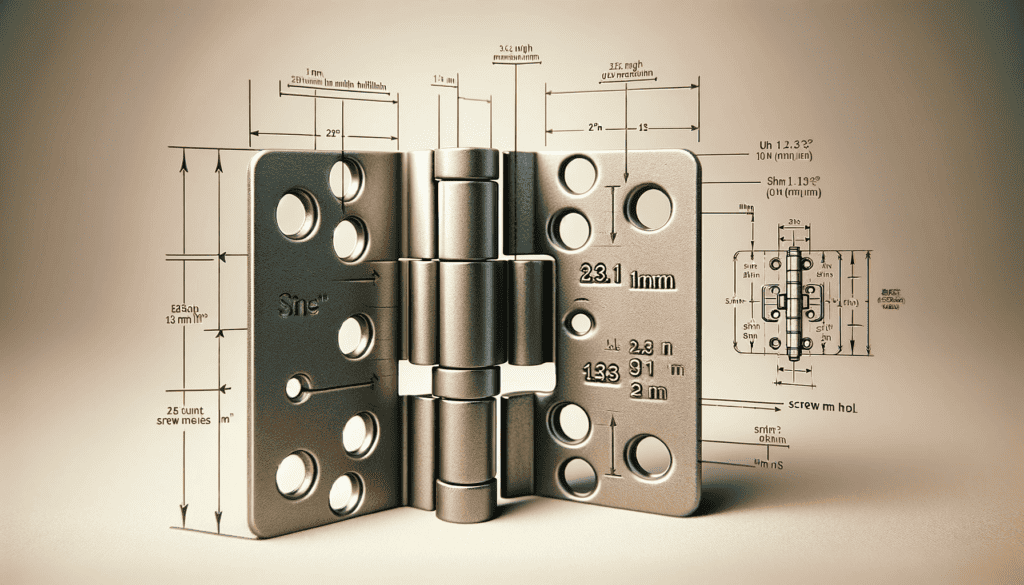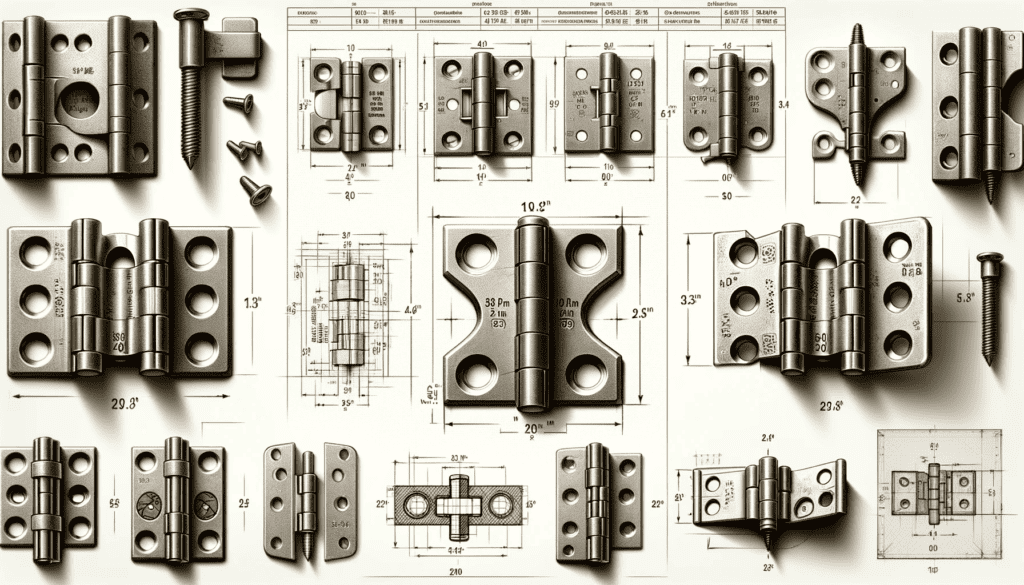
Hinges play a vital yet often overlooked role in our daily lives. From the squeaking cabinet door in our kitchen to the satisfying click of a high-end luxury vehicle’s door, hinges enable items to swing, lift, and pivot smoothly and silently. With centuries of innovation in materials and design, hinges have evolved dramatically from crude leather and wooden contraptions to the precise, durable metal varieties we know today. But amidst the endless options and applications, one key question arises – what are the standard hinge sizes in millimetres?
This comprehensive guide delves into the nuances of standard hinge sizes for residential and commercial settings. You’ll learn insider tips like the ideal size range for a typical interior door, the enhanced durability offered by commercial-grade hinges, and essential considerations like material thickness. We’ll decode hinge sizing conventions so you can shop confidently, replace hinges accurately, and select the perfect hinge for every situation.
Intriguing Facts About Hinge Evolution
Before diving into the specifics, it helps to understand how hinges came to the dimensions we see today. Hinges have a rich history dating back thousands of years. Some fascinating facts include:
- Ancient Hinges: Early hinges were crude leather or wooden pieces with a basic strap and pin design. These were common in Ancient Egypt, Rome, and China to enable doors and containers to open and close.
- Renaissance Metal Hinges: Blacksmiths began forging metal hinges from iron during the Middle Ages and Renaissance era. This improved durability, but the hinge shapes remained rudimentary.
- 18th Century Advances: Rising quality standards and architectural ornate styles spurred innovations like interlocking joints between metal leaves and adjustable tension screws.
- 20th Century Standardization: Modern mass production enabled standard hinge sizes and types standardization for residential and commercial use. New materials like stainless steel also enhanced corrosion resistance.
While the technology has advanced dramatically, many standard hinge sizes today still reference traditional dimensions that evolved over centuries of artisanal craftsmanship. But functionality, durability and design aesthetics also influence the ideal size for different hinge types and applications.
Typical Dimensions of Common Residential Door Hinges
For hinges used in conventional houses, the most ubiquitous shapes and sizes include:
- Full Mortise Hinges: These door hinges are embedded into cavities carved into both the door and frame for a seamless appearance. Typical Size – 88.9 mm x 88.9 mm (3.5” x 3.5”)
- Half Mortise Hinges: Only partially recessed into the door or frame, exposing partial hinge hardware. Typical Size – 76.2 mm x 102 mm (3″ x 4″)
- Full Surface Hinges: Installed onto the outside face of the door and door frame. Typical Size – 89 mm x 89 mm (3.5″ x 3.5″)
- Ball Bearing Hinges: Similar dimensions but incorporate internal ball bearings for smooth motion. Typical Size – 88.9 mm x 88.9 mm (3.5” x 3.5”)
- Cupboard Hinges: Smaller hinges for cabinets and cupboards. Typical Size – 50.8 mm x 50.8 mm (2″ x 2″)
These sample common hinge sizes for standard interior doors are between 1.8 m to 2.1 m (6′ to 7′) in height. However, larger hinges would be recommended if dealing with more oversized custom doors.
Commercial and Industrial Doors Demand Oversize Hinges
While residential hinges typically max out around 102 mm (4″) in square dimensions, commercial and industrial doors require larger, beefier hinges to bear heavier loads. Standard extra-large sizes include:
- Full Mortise Hinges: Up to 190.5 mm (7.5″) square for heavy-duty commercial doors.
- High-Frequency Hinges: Designed for public entrances with high traffic. At least 127 mm (5″) square.
- Strap Hinges: Simple rectangular plates joined at one side by a strap. Around 127 mm x 254 mm (5″ x 10″) dimensions.
- Continuous Hinges: Hinges formed from a single piece spanning the entire door height. Extended length options.
- Spring Hinges: Integrated torsion springs assist in opening heavy doors. Minimum 102 mm (4″) square size.
The enhanced thickness also improves durability. While residential hinges are typically between 2.54 mm and 3.175 mm thick, commercial ones often range from 3.175 mm to 4.7625 mm. So, if your building has oversized doors, always opt for the larger commercial hinge size.
| Hinge Type | Typical Residential Size | Typical Commercial Size |
|---|---|---|
| Full Mortise | 88.9 mm x 88.9 mm | 127 mm x 127 mm |
| Half Mortise / Full Surface | 76.2 mm x 102 mm | 127 mm x 190.5 mm |
| Continuous | 76.2 mm height | 190.5+ mm height |
| Spring | 88.9 mm x 88.9 mm | 127 mm x 127 mm |
| Ball Bearing | 88.9 mm x 88.9 mm | 127 mm x 127 mm |
Specialty Hinges with Unique Size Considerations

Beyond bare door hinges, specialized hinge varieties are designed for particular applications and environments. Some unique sizing considerations include:
- Flag Hinges: Used on exterior doors in high wind conditions. Reinforced leaf size of 117 mm in height, 90 mm open width, and 14 mm in depth.
- Concealed Hinges: Used for invisible cabinetry integration. Compact shapes like 20 mm x 35 mm are standard.
- Pivot Hinges: Allow swinging and pivoting. The base plate is 150 mm x 150 mm; the pivot assembly is 50 mm tall.
- Tee Hinges: Include an intersecting strap for multi-directional swing—around 140 mm in size.
- Butt Hinges: For overlay cabinet doors—squarish shape with edge lengths around 32 mm to 64 mm.
- Butterfly Hinges: For inset cabinet doors. The central butterfly-shaped plate is the main square.
So, specialty hinges tailored for a specific role may deviate from standard sizing conventions. Always check exact measurements before purchasing.
Residential vs Commercial Hinge Size Comparison
A side-by-side photographic comparison highlights the considerable size difference between residential and commercial hinges.
While the residential hinge on the left suits everyday interior doors, the oversized commercial hinge on the right is needed for heavy-duty operation. This significant dimension gap demonstrates why industrial or public access doors require robust, big hinges well beyond 100 mm in size.
The benefits of the larger commercial hinge include:
- Enhanced durability for frequent use and abuse
- Smoother motion under heavy-weight loads
- A smoother wear for recurring heavy-weight cycles
- Greater fastener size to distribute force
Pros know to size up when selecting a commercial property and heavy doors. Trying to cut costs with undersized hinges leads to premature failure.
Hinge Design Trends: Innovation Meets Practicality
Just as smartphones integrate ever-more advanced features, hinge design also pushes the boundaries of functionality. Some interesting trends include:
Adjustability: Hinges with screw adjusters built-in for re-aligning doors and managing sagging issues in old frames. No need for shims or refitting.
Self-Closing: Internal springs or pistons that automatically return doors to the closed position, ideal for bathrooms and entries.
Concealed Hinges: These open cabinet doors or other surfaces have no visible hinge for minimalist contemporary interiors. Favored by architects and designers.
Bright Hinges: Advanced hinges can now signal when a door opens via WiFi to smart home systems. Helpful for monitoring elderly occupants.
Decorative Hinges: Ornate hinge designs that make a visual statement, like a satin nickel finish for a modern high-rise apartment. It’s an aesthetic upgrade.
Continuous Hinges: Annges are formed from a single long plate for full-height support. Eliminates the gap between individual hinges. They are used on commercial storefronts and glass doors.
While most quality hinges adhere to long-established size norms, innovative form factors and materials continue advancing functionality. Professional installers can select hinges to balance visual appeal and technical capabilities.
Measuring Hinge Size Accurately with the Right Tools

Installing or replacing hinges relies on careful measurement of both the hinge and door mortise (recessed cavity). Here are some tips for measuring success:
Get Precise Hinge Dimensions: Use a dial calliper, digital calliper, or engineering calliper to accurately calliper hinge length, width, and thickness. Avoid guessing or eyeballing.
Account for New Finish Buildup: If repainting, measure hinge dimensions before adding new paint layers that can impact fit.
Mind the Mortise Depth: Mortise depth should equal at least half the hinge thickness to avoid looseness or instability.
Match Drill Bit to Screw: Confirm your drill and screw head size match the hinge holes. A tight fit prevents stripping.
Use a Jig: For a tight uniform alignment, use a hinge mortise jig when cutting mortises into the door and frame.
Rushing through hinge measurements leads to amateurish loose fits and misalignment. Take time to measure meticulously before cutting, drilling, or installing for results like a seasoned pro.
Consequences of Using the Wrong Hinge Size
Hinge sizing is certainly no guessing game. Improperly sized hinges lead to several problems:
- Door Sag: Hinges too small for the door’s weight capacity will sag over time as the pins and screw fasteners weaken and elongate the holes.
- Hinge Sticking: Bulky paint buildup into hinge mortises can cause residential hinges to bind and stick in the open position.
- Door Alignment Issues: Imprecise mortise cuts prevent proper door closure and sealing, especially with oversized commercial hinges.
- Aesthetic Flaws: Using commercial hinges on residential doors looks clunky and unappealing. Similarly, dainty residential hinges on commercial doors appear undersized.
- Premature Hinge Failuappearstant wear and door slamming will quickly destroy lightweight residential hinges in heavy traffic installations.
- Loose Hardware: Hinges, even 1 or 2 mm too small for the mortise opening, will soon rattle and feel flimsy.
Professionals avoid these pitfalls through careful planning, measurement, and hinge selection for the intended application. While close enough may work temporarily, wrong hinge sizing always shows through poor performance and aesthetics.
FAQs: Your Pressing Hinge Size Questions Answered
Still, I have some lingering questions about the nuances of hinge sizes. Here are answers to a few frequently asked questions:
Q: How does hinge thickness affect performance?
A: Thicker hinges are inherently more robust and more durable under load. The minimum thickness should equal half the minimum depth. Max thickness depends on door clearance off the frame.
Q: Are hinges sized differently for bi-fold and French doors?
A: The multi-panel nature and weight of bi-fold and French doors require particular hinges. For French doors, use full-length continuous hinges. For bi-folfull-lengthra, tall hinges are at least 127 mm long to span the door sections.
Q: Does the hinge material and plating affect size?
A: Not significantly, but a zinc alloy hinge will be slightly bulkier than steel. Decorative plating, like brushed nickel, adds negligible thickness. Use plated hi ranges in the same mortise as unplated equivalents.
Q: Can I get custom-made hinges for unique architectural needs?
A: Many hinge manufacturers accommodate custom sizing for non-standard applications like historical renovations or unique contemporary designs. Expect extended lead times and higher costs, though.
What Are the Standard Dimensions of Hinges and How Do They Relate to Hinge Hole Sizes?
Understanding hinge hole sizes is crucial when considering the standard dimensions of hinges. The diameter of the hinge hole should match the diameter of the hinge knuckle. For example, a 35mm hinge requires a 35mm hole. The proper alignment ensures seamless installation and smooth operation of the hinge.
Closing Thoughts on Hinge Sizing, Selection
From a glimpse of antiquity to modern innovations, we’ve covered the key considerations, standard sizes, and best practices regarding hinge dimensions. While often overlooked, appropriately sized hinges are critical to aesthetics and long-term functionality. So, apply these insights to your next project’s ideal hinge selection.
High-traffic commercial doors always size up to the larger, sturdier hinge dimensions. But for residential settings, keep traditional sizes around 76 mm to 102 mm range to maintain a proportional fit. Beyond the numbers, consider functional factors like self-closing features and corrosion resistance. With critical doors and cabinets, investing a few extra dollars in quality hinges prevents thousands in repairs down the road.
Hopefully, this guide provides the essentials to evaluating hinge sizing for smooth operation and enduring performance for years to come. Next time you see a door hinge, you’ll appreciate how far this humble hardware has evolved.

Hi, I’m George Anderson, an expert installer with an extensive door installation and maintenance background. I’m passionate about sharing my knowledge on door equipment and accessories through my writing, helping homeowners make informed decisions. My specialty lies in custom door installations, with a commitment to enhancing the aesthetics of every home. Please feel free to reach out anytime for help with door-related questions or needs.










